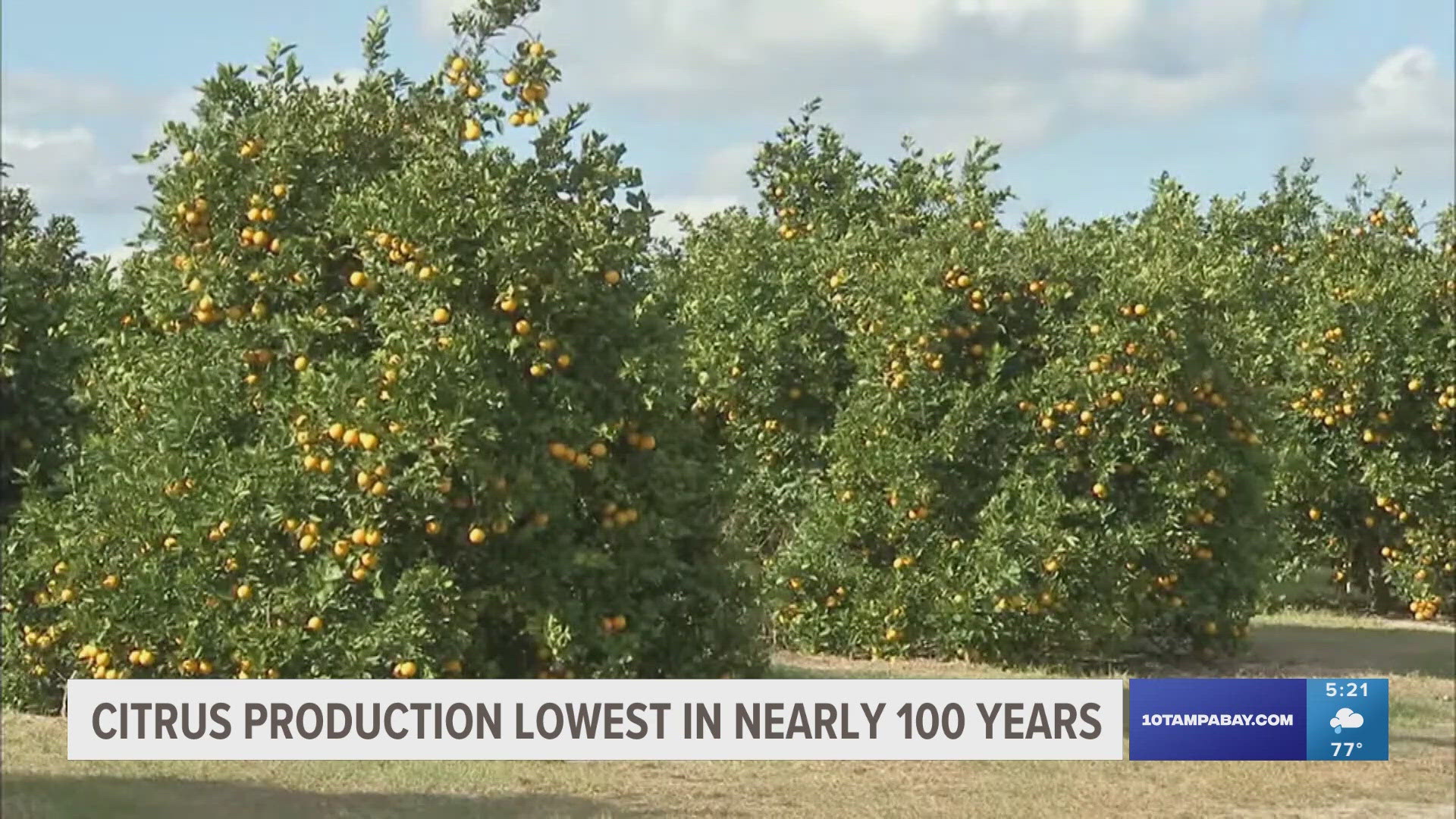ST. PETERSBURG, Fla. — Florida’s citrus industry limped to the end of the 2023-2024 growing season, with farmers hoping newly planted and recovering trees can avoid hurricane damage this year.
The U.S. Department of Agriculture on Friday released a final report about the 2023-2024 season and slightly boosted estimates of orange production from a June report. Overall citrus numbers were up 11.4 percent from the 2022-2023 season — but 2022-2023 had the lowest production in nearly 100 years.
Steve Johnson is a fourth-generation citrus grower, with hundreds of acres across central Florida.
“Citrus has kind of always been in our family,” he said. “In multiple counties, being Hardy, Polk, and Manatee.”
He says near every tree he owns is plagued by citrus greening disease and aftermath of Hurricane Ian, which he said took out 60% of his groves in 2022.
“As the tree is infected, we lose 30% of our roots in the first year,” said Johnson. “So, you add storms, you add cold weather, you add more stress of any kind to it, it takes us longer to return and get back growing.”
Matt Joyner, executive vice president and CEO of Florida Citrus Mutual, expressed optimism about the industry while acknowledging the industry’s ongoing recovery from 2022’s Hurricane Ian requires “favorable weather conditions.”
“We just really need to make it through this year,” Joyner said. “Let these trees recover, and let’s get a good harvest and something we can start building some momentum on.”
The industry has been in a hyper-recovery mode since Hurricane Ian caused massive damage to groves as it swept across the state. Growers have expressed a need for two or three seasons for impacted trees to recover and new plantings to take hold.
“We are seeing the fruit sizing up, and the tree health is looking pretty good. We are hopeful that coming into the (next) season and the harvest, that the trees are going to be able to hold onto that fruit,” Joyner said. “As they’ve had a little bit of time to recover from the storms, tree health is looking better.”
Even before Hurricane Ian, the industry had seen reduced production as it confronted residential and commercial growth, increased foreign competition and the effects of "greening," which has decimated groves for a little more than two decades and is spread by the Asian citrus psyllid, a small bug that carries a bacteria that causes the disease.
“With new therapies and new tools that we've got in the toolbox, we're able to counteract greening to a better degree,” said Johnson, who also serves as Chairman of the Florida Citrus Commission.
The production numbers released Friday were 11.8 percent below what the U.S. Department of Agriculture expected in an initial forecast for the 2023-2024 season and more than 52 percent lower than production during the 2021-2022 season, which was before Ian.
Sen. Ben Albritton, a Wauchula Republican and citrus grower who is slated to become Senate president in November, said last month he intends to “deploy energy, resources, you name it at the state level to help intervene into what is … a really, really bad situation.”
Friday’s report estimated the state produced 17.96 million 90-pound boxes of oranges during the 2023-2024 season. That was up from 17.86 million boxes projected in a June report. It also was higher than the 15.82 million boxes produced during the 2022-2023 season, which was the lowest orange total since the 1934-1935 season.
Grapefruit production ended the 2023-2024 season at 1.79 million boxes, which was lower than the 1.81 million boxes produced in 2022-2023 and the 3.33 million boxes in 2021-2022.
Before the 2022-2023 season, the last time Florida’s grapefruit production was under 2 million boxes was in the 1911-1912 harvest.
Specialty crops, primarily tangerines and tangelos, ended the 2023-2024 season at 450,000 boxes, the lowest ever recorded. Specialty crops were first listed separately in the citrus report after the 1919-1920 season, when the total was 478,000 boxes.
Growers filled 480,000 boxes of specialty crops in the 2022-2023 season, which was down from 750,000 boxes in 2021-2022.

